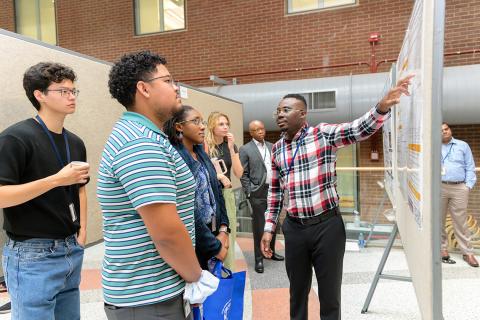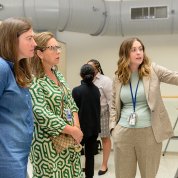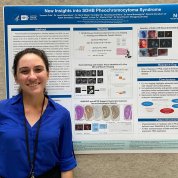Scientists Showcase Findings at Festival Poster Sessions

Photo: Marleen Van Den Neste
Dozens of NIH researchers gathered in the FAES Terrace at the Clinical Center to present their recent studies during the NIH Research Festival Poster Sessions on Sept. 18 and 19. (A virtual poster session was held on Sept. 20.) From health disparities and stem cell biology to cancer and genomics, postbacs and postdocs shared their findings with peers and other members of the research community.
Dr. Renée Groechel, a postdoc with the National Institute of Neurological Disorders and Stroke, investigated how healthy social relationships in midlife might later protect one from developing Alzheimer’s disease and related dementias, even if the individual has amyloid pathology that is highly associated with dementia.
Data showed that having strong social relationships in midlife doesn’t necessarily modify the association between pathology and developing dementia, but Groechel and her co-authors found that strong social relationships in midlife did offer some level of protection from getting dementia in later life.

Photo: myranda tarr
“While social relationships didn’t weaken the association between having amyloid pathology and dementia, it independently showed that you’re a bit less at risk to develop dementia if you have healthy social relationships in midlife,” she explained.
In efforts to further understand how social relationships are linked to reduced dementia incidence, Groechel is now examining whether strong social relationships in midlife may modify the association between imaging markers of cerebrovascular disease and dementia.
Markus Hoffmann has been working with the National Institute of Diabetes and Digestive and Kidney Diseases for the last six months as he transitions to a postdoc position. He was interested in delving deeper into the circular RNA field–an area not widely researched because it can be hard to grasp.

Photo: myranda tarr
He aimed to investigate data sets and make computational analysis feasible for biologists with no computation experience to investigate circular RNA in their data. This goal led to the development of a nextflow pipeline that is easy for everybody to use and in the end will produce visual insights into the user’s data.
“Data is linear so how would you get information about something circular in a linear context?” posed Hoffmann. “With the current tools, biologists were just overwhelmed with technicalities. With my pipeline, they can now finally include circRNA analysis routinely in their research.”
A Ph.D. student in the Neuro-Oncology Branch of the National Cancer Institute, Yasemin Cole is studying hypoxia, a low quantity of oxygen, and how it can regulate whether someone develops cancer.
“Oxygen is very important—as we go up to a high altitude, we can feel like we’re in need of air,” explained Cole. “Similarly, our cells need that air to replenish nutrients to survive, and—at least in this case with mice—we think that having a lack of oxygen may be causing these cancerous cells to proliferate and develop further.”
Through a first-of-its-kind mouse model focusing on hypoxia and pheochromocytoma, a rare adrenal gland tumor, Cole saw that changing one gene influences cancer development. The findings explore the concept of cancer and how it develops.

Photo: myranda tarr
“Is it something we see in older age or something that happens really early in development, continues to persist and then progress into a cancer?” posited Cole. “We are studying the mechanisms to why we are seeing that.”
The poster sessions were one component of the first in-person festival since September 2019. The week-long event highlights the diversity of scientific disciplines within NIH’s Intramural Research Program.






